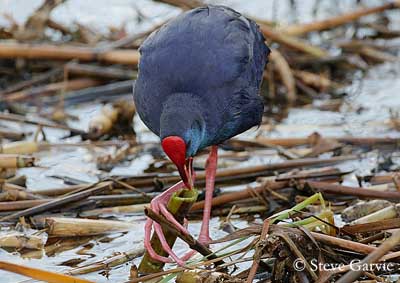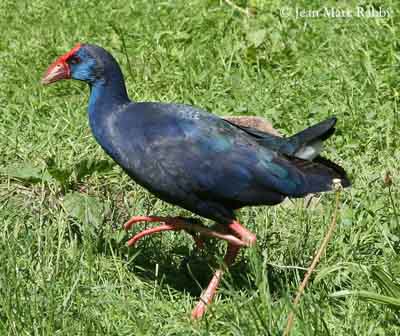
Purple Swamphen
Porphyrio porphyrio
Gruiforme Order – Rallidae Family
BIOMETRICS: (nominate race)
Length: 38-50 cm
Wingspan: 90-100 cm
Weight: 725-870 g
DESCRIPTION:
The Purple Swamphen has silky purple-blue plumage with metallic gloss on throat and breast, contrasting with the white undertail coverts.
Fr: Talève sultane
All : Purpurhuhn
Esp : Calamón Común
Ital: Pollo sultano
Nd: Purperkoet
Sd: Purpurhöna
Port: Caimão
Photographers:
Aurélien Audevard: OUESSANT DIGISCOPING
Jose Luis Beamonte: Pájaros de España
Didier Buysse: Vision d’Oiseaux
Jean Michel Fenerole: Photos d’Oiseaux
Stave Garvie: RAINBIRDER Photo galleries
Paul Guillet: Photos d'Oiseaux
Patrick Ingremeau: TAMANDUA
Jean Marc Rabby: Des Ailes et des Plumes
Callie de Wet: GALLERY
Text by Nicole Bouglouan
Sources:
HANDBOOK OF THE BIRDS OF THE WORLD Volume 3 by Josep del Hoyo-Andrew Elliott-Jordi Sargatal - Lynx Edicions - ISBN : 8487334202
THE HANDBOOK OF BIRD IDENTIFICATION FOR EUROPE AND THE WESTERN PALEARCTIC by Mark Beaman, Steve Madge - C.Helm - ISBN: 0713639601
LES OISEAUX DE THAILANDE par Roland Eve et Anne-Marie Guigue - Times Editions - ISBN: 9812042008
BIRDS OF THE MIDDLE EAST by R.F. Porter, S. Christensen, P Schiermacker-Ansen C.Helm - ISBN: 0713670169
BIRDS OF AFRICA SOUTH OF THE SAHARA by Ian Sinclair and Peter Ryan - Princeton University Press Princeton and Oxford - ISBN: 0691118159
BIRDS OF THE GAMBIA AND SENEGAL by Clive Barlow and Tim Wacher – Helm Field guides – ISBN: 0713675497
BirdLife International (BirdLife International)
Pájaros de España (JL Beamonte)

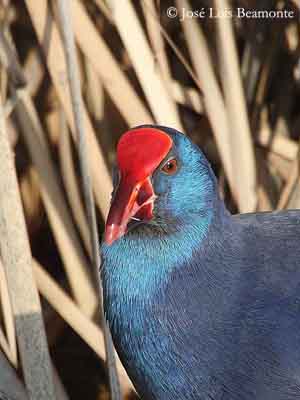
The very large bill is triangle-shaped, with bulky and curved upper mandible, giving the bird a strange appearance. The bill extends to the head top in a bright red shield, as bill and long legs. The slender toes show fine claws, and especially the rear toe.
Eyes are red too.
Both sexes are similar.
We can find 13 subspecies which differ in size and colours, although all races have in common the dominant purple-blue tonality. Gloss is variable, more or less pale or dark. The upperparts range from purple-blue to dark brown, through bronze-green and pale chestnut.
The races are: porphyrio, madagascariensis, caspius, seistanicus, poliocephalus, viridis, indicus, pulverulentus, pelewensis, melanopterus, bellus, melanotus and samoensis.
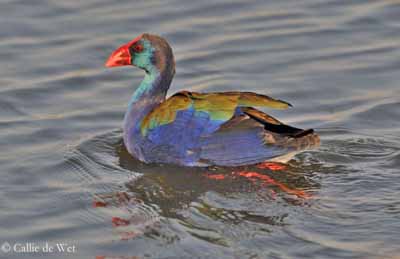
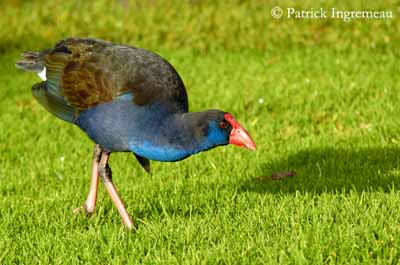
Race "madagascariensis" - South Africa
Race "bellus" - Western Australia
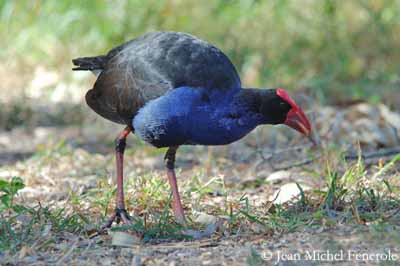
Race "melanotus" - Queensland - Australia
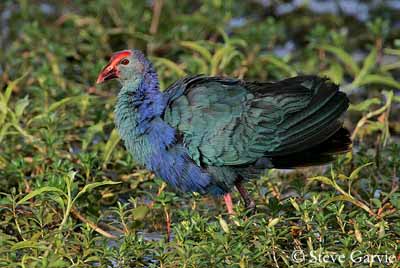
Race "poliocephalus" - Sri lanka
VOICE: SOUNDS BY XENO-CANTO
The Purple Swamphen’s voice is something difficult to define.
When the bird takes off, the call is very similar to the sound produced by a small trumpet. There are several other rich and varied sounds. The call is given from a hidden place in the dense vegetation, and often at night.
Another call is a kind of wailing, a series of powerful continuous sounds which grow louder and louder, and reach an impressive human sonority. This call is uttered at the end of the day and in the darkness by only one individual.
Other calls are shorter and raucous, from growl to bell’s sound, ending in a last blow of trumpet.
Many calls are uttered in chorus by several swamphens and always by night, increasing in intensity while the excitation goes up.
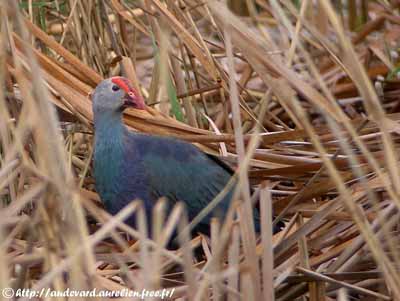
Race "caspius"
Syria
HABITAT:
The Purple Swamphen frequents the marshes with sedges, where flood and dryness alternate. At this moment, the birds reach coastal lagoons and rivers where they spend the late summer and the autumn, until the new flood of the marshes with rains and the rising of water level.
RANGE:
Europe, Africa, Asia, Australia, New Zealand.
The Purple Swamphen does not perform long distance migrations, but some seasonal movements are observed in response to the changes of water level and habitat conditions.
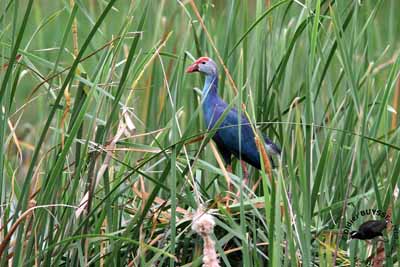
Race "viridis"
Thailand
BEHAVIOUR:
The Purple Swamphen feeds in a strange way, using its long toes. It feeds while walking if it is protected, along the muddy area close to the reeds.
The food is taken with one leg, mainly the right leg. The food items are held between the toes and raised until half of height separating them from the bill.
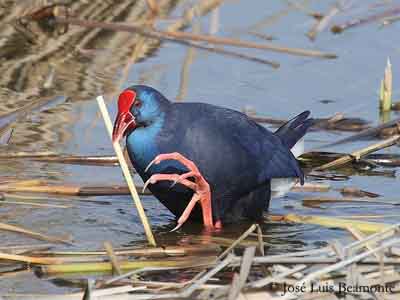
Race
porphyrio
If a piece of food falls down, it is recovered with the toes instead of the bill, but the attempt often fails. The pieces of roots impossible to move in this way are maintained on the ground with the toes and torn to pieces with the bill.
The Purple Swamphen was seen feeding its young with reed sap, tearing off the stems with the bill and taking them with the toes, as a parrot!
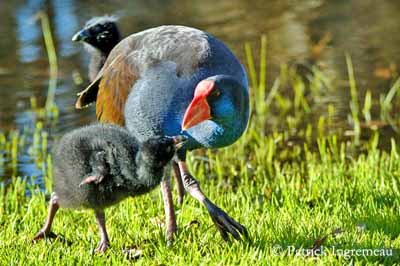
Race "bellus"
Western Australia
Social structure and mating system are fairly complex, especially in New Zealand, whereas in western Palaearctic, they have monogamous pair-bonds. All are permanently territorial.
Except for the races “porphyrio” and “madagascariensis” which are monogamous, most of the other subspecies live in groups with breeding males and females, and helpers. The females lay in communal nest.
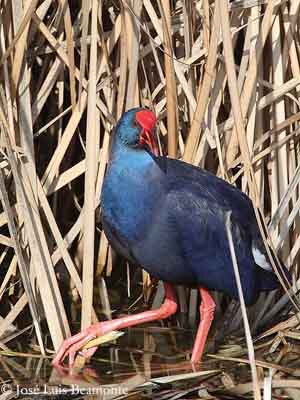
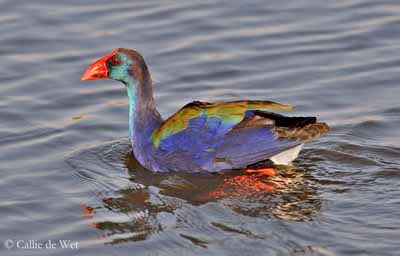
Race "madagascariensis" - South Africa
FLIGHT:
The Purple Swamphen flies relatively well with dangling legs, allowing to identify the bird at some distance. But its appearance in flight lacks elegance!
REPRODUCTION:
The Purple Swamphen starts to build the nest when the vegetation is still short. This is a floating nest placed concealed in dense reeds, a platform made with dry stems at base, covered with large leaves and surmounted by a tunnel made with aquatic leaves. The nest is built by both parents in shallow water, but sometimes in deeper water.
This is a huge structure. In fact, it is a mount of dead reeds on the bottom, and only emerging of some centimetres. Each nest has one or two access-ramps.
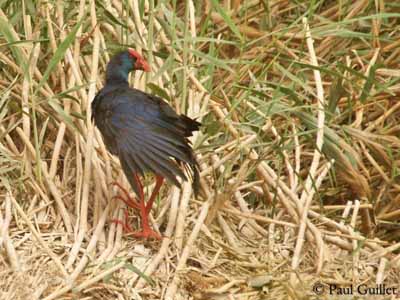
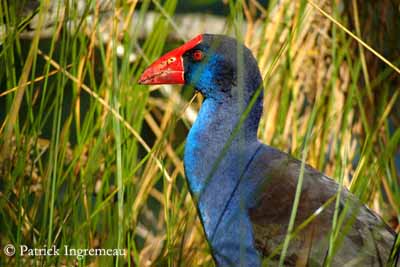
Race "seistanicus" - Qatar
Race "bellus" - Western Australia
The laying occurs in April-May. Female lays the eggs in a roughly done cup. They are fairly large and glossy, with pale shell which may vary in tinge and spotted purplish and brown.
Incubation lasts about 25 days. The chicks leave the nest 4-5 days after hatching. They are covered in black down, legs are red with long toes and claws are black. The bill is yet stout, dark grey with bright red at base. The first feathers which appear very soon, are yet purple-blue, typical of immature birds. They grow up quickly, fed by both parents. In young, the red of the bill starts by the shield, and reaches the whole bill in August.
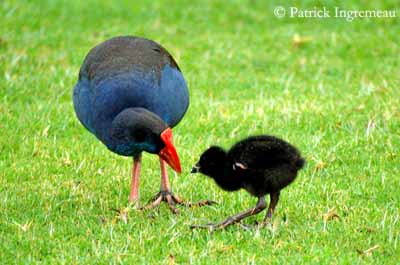
Race "bellus"
Western Australia
DIET:
The Purple Swamphen is primarily vegetarian and feeds on stems and sap from aquatic plants. It may sometimes consume dead fish found between two canals.
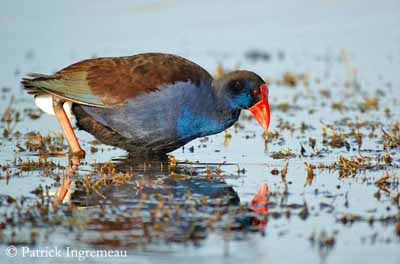
Race "bellus" - Western Australia
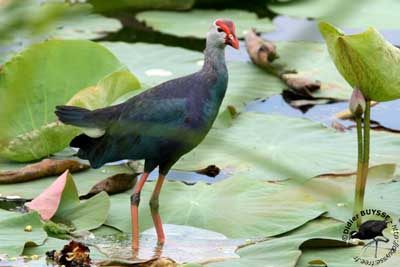
Race "viridis" - Thailand
PROTECTION / THREATS / STATUS:
The Purple Swamphens have some impact on their own habitat where they consume the roots. Sometimes, the marshes they crossed have spectacular appearance. However, the power of regeneration of these reeds’ species (typha, carex, scirpus, communis) is important, making difficult for the birds to destroy their own habitat. In addition, they avoid its too wide expansion.
The Purple Swamphen is protected in most parts of its range, but hunting pressure, collect of the eggs, drainage of wetlands and pollution by insecticides and lead are an important threat for this species.
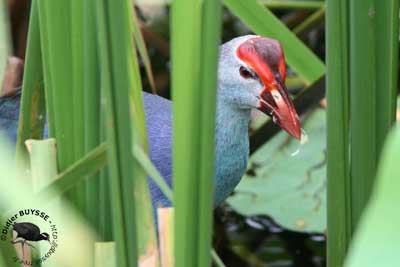
Race "viridis" - Thailand
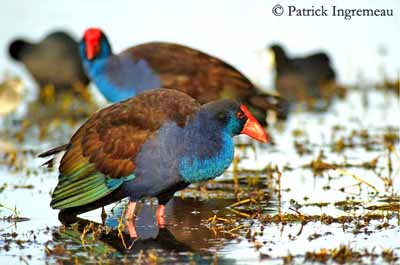
Race "bellus" - Western Australia
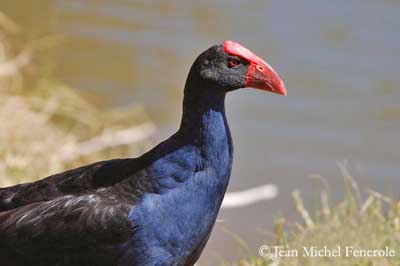
Race "melanotus"- Queensland - Australia
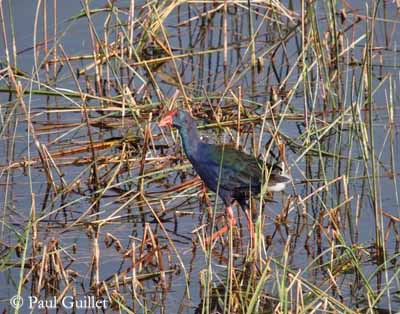
Race "seistanicus" - Qatar
